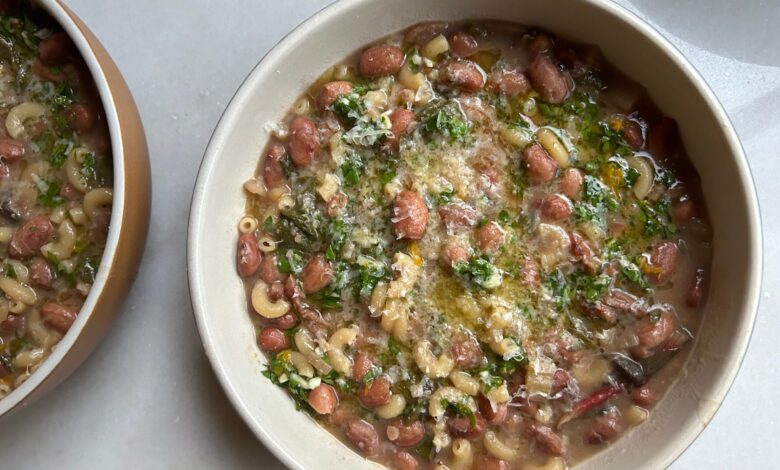How to Turn Anything into Soup

[ad_1]
Let’s say you’re home, it’s very cold out, you’re craving soup, and you don’t feel like going to the grocery store. Some might see this as a hopeless situation. I see it as an opportunity.
You can turn almost anything into soup. The chickpeas in you cupboard? Those can be a soup. The celery root that you bought to make that Ottolenghi recipe that you gave up on? That can be soup too. Eggplant can be soup, spinach can be soup, even the cheddar cheese in your cheese drawer can be soup; just add broccoli. Or beer.
For the purposes of this column, let’s focus on the kind of thrown-together soup that I like to make: a hearty, vegetable-packed soup with beans and greens and a little Parmesan on top. Do I shop for those things? Sometimes. Usually, though, I just see what I have lying around and go from there.
Your starting point needs to be fat. More often than not, that fat will be extra-virgin olive oil. But if you want to shake things up a bit, you can use butter (ideal in a squash soup), you can render bacon or sausage (excellent in a lentil soup), you can even use lard, if you’re the kind of person who keeps lard around, in which case, respect.
Once you heat your fat, you add your aromatics. In France, you would add mirepoix. In Italy, you would add soffritto. Fun fact: those are the same thing – a combination of chopped onions, carrots, and celery. Don’t have celery? Just add onions and carrots. Don’t have carrots? Just add onion. The main thing is that you season at this stage with salt because you don’t want Tom Colicchio showing up to your kitchen saying, “You didn’t develop any flavor.” (He always says that on Top Chef.)
The aromatics don’t have to stop there: like garlic? Add tons of garlic. The more you chop your garlic, the more garlic flavor it’ll release. So, if you slice the garlic it’ll be less garlicky than if you mince the garlic. You could also add ginger here, chili flakes, green pepper (if you’re going for a Cajun vibe, in which case omit the carrots – then you’ll have what’s called “The Holy Trinity.”) You could add tomato paste here and toast it in the fat, to caramelize it (a cool trick) tinting your soup red; or you could add anchovy paste, to give your soup a surprising hint of umami.
The concept here is that you’re flavoring the fat with the aromatics and then that flavored fat will infuse whatever you add next. If you were making Ribollita (Italian kale and cabbage soup), you could add a bunch of sliced cabbage and Tuscan kale at this stage, being sure to season, stirring all around and then, when it’s softened, adding water or stock — just enough to cover (season again). Then add a can of drained white beans and let it all simmer until everything comes together, for about an hour. If it gets too thick, add more stock/water.
Another direction you could go is to add a can of tomatoes instead of the kale/cabbage, plus stock, throwing in a Parmesan rind or two to make a cozy tomato soup. Putting a Parmesan rind into an improvised soup is like putting Tina Fey into your improv show: it’s bound to make things better. If you want to be indulgent, you could also add cream. It’s the winter, why not? You deserve it.
The other kind of soup to make is the kind where you add something hard but porous – think Butternut squash, think potatoes, think fennel – and allow it to cook in the liquid for an hour or so until a knife goes through it easily, at which point you blend or smash, depending on what kind of texture you prefer – chunky or smooth.
A bit about the liquid: you may think water is a wimpier choice than stock, but water has its merits. Water is free and there aren’t weird chemicals and unknown ingredients pumped into it, which isn’t always true of your stock. As long as you season as you go, you’ll be fine.
Sometimes it’s fun to throw in another liquid in with your water or stock to make things more complex. Example: apple cider for the squash soup. White wine for the Ribollita (add it after you cook your aromatics and be sure to cook off the alcohol before adding the stock). You can doctor a soup that’s a little dull at the end with lemon juice, balsamic vinegar, apple cider vinegar, fish sauce, yuzu kosho, Tabasco, whatever you think will make your soup taste better.
And that’s the most important step of all: tasting your creation. If you’re going to throw together a soup, it’s on your shoulders to carry it across the finish line. (Look at me and my sports metaphor.) If something’s not working, don’t throw your soup away. Figure out where it’s gone wrong then figure out how to fix it. Sometimes all it takes is adding a significant amount of salt and a glug of vinegar. And there’s no soup problem that a sprinkling of Parmesan cheese can’t solve.
This is also the perfect opportunity to use up leftover roast chicken: just shred it and throw it in at the end. It’s also an excellent way to use up leftover salad greens. I’ve seen Ina Garten dump leftover fully dressed salad into a soup and blend it. If it’s good enough for Ina, it’s good enough for us.
In conclusion, soup is the perfect way to play around in the kitchen without causing real harm to yourself or others. And if things really don’t turn out, just change the name. A failed minestrone is a success if you call it “a deconstructed minestrone.” And worst comes to worst, you can always pop open a can of Campbell’s.
Adam Roberts writes the bi-weekly newsletter Amateur Gourmet and is the author of three books, including Secrets of the Best Chefs and Give My Swiss Chards to Broadway: The Official Broadway Lover’s Cookbook (with Tony-nominated actor, Gideon Glick). He lives with his husband and dog in Brooklyn.
Thank you, Adam! We love your newsletter.
P.S. Magic one-pot pasta and five recipes worth memorizing.
(Photos courtesy of Adam Roberts.)
[ad_2]
Source link










